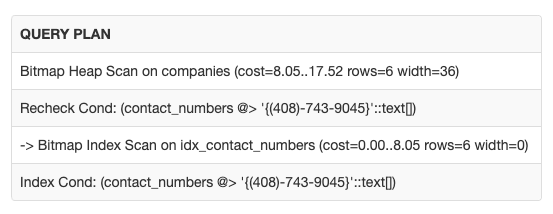In a Rails application, adding an index to any database column is just a one-liner migration.
add_index :table_name, :column_nameWhile learning more about Postgres database indexes, you would have come across the fact that Postgres provides several index types, from which B-Tree is the most famous one.
But do you know what type of index is used in the migration above? Postgres by default applies the B-Tree index, unless specified explicitly.
Other than the B-Tree type index, there is one more most useful index-type GIN(Generalized Inverted Index). Here in this article, we are going to look at the GIN index and how it's used in Postgres databases.
A question may come to your mind, what is special about GIN index?
GINindexes are the perfect choice for “composite values” where you perform a query that looks for an element within such “composite” columns likejsonb,arrayorhstoredata structures.
GIN index for text columns:
These days most applications have a search feature. Searching with small string columns which store single values like name, city, etc works fine with the B-Tree index. But when it comes to full-text searching with text type columns, is the B-Tree index that helpful? Let's try to find out.
Consider the following example, here we are creating messages table, having recipient_id and message_body columns and adding an index on the message_body column.
CREATE TABLE messages (recipient_id INTEGER, message_body TEXT);
CREATE INDEX idx_message_body ON messages(message_body);Since we have not provided any index type, it will create a B-Tree index. Let's verify that here:
SELECT
indexname,
indexdef
FROM
pg_indexes
WHERE
tablename = 'messages';
Now let's add a row with a lengthy message_body :
INSERT INTO messages(recipient_id, message_body)
VALUES (11, repeat('Hello, I am Swati. ', 90000) )
RETURNING *; This will give an output as:
ERROR: index row requires 19616 bytes, maximum size is 8191And if you are trying the same in Rails application, it will throw an error like:
PG::ProgramLimitExceeded: ERROR: index row requires 19616 bytes, maximum size is 8191
01 : CREATE INDEX "idx_message_body" ON "messages" ("message_body")Are you wondering why this error was thrown? Let's first check the size of our index.
select * from pg_relation_size('idx_message_body');
Here the B-Tree index is not sufficient for our requirement. And hence the GIN index comes to rescue :) Let's try adding an index of type GIN.
CREATE INDEX idx_message_body ON messages USING gin (message_body gin_trgm_ops);
And to achieve this in Rails, you need to add migration as follows:
class AddBodyIndexOnMessages < ActiveRecord::Migration
def up
enable_extension("pg_trgm");
add_index(:messages, :message_body, using: 'gin', opclass: :gin_trgm_ops)
end
def down
remove_index(:messages, :message_body)
end
end

The
pg_trgmmodule provides functions and operators for determining the similarity of ASCII alphanumeric text based on trigram matching, as well as index operator classes that support fast searching for similar strings.
Let's run the query again:
EXPLAIN INSERT INTO messages(recipient_id, message_body)
VALUES (11, repeat('Hello, I am Swati. ', 90000) )
RETURNING *;

Let's try searching the message body with the following query. Now, if you execute the query, you will find that the database engine uses the index for lookup:
EXPLAIN SELECT *
FROM messages
WHERE message_body ILIKE '%Swa%';

This is how we can use GIN index in our application to search values in text columns.
GIN index for array columns:
Let's look into how we can use GIN index for the array data structure. Take an example of companies database storing multiple contact numbers.
CREATE TABLE companies (company_code INTEGER, contact_numbers TEXT []);
CREATE INDEX idx_contact_numbers ON companies USING gin (contact_numbers);To search company records by matching contact number:
EXPLAIN SELECT *
FROM companies
WHERE contact_numbers @> ARRAY['(408)-743-9045'];
This is how the GIN index helps us to apply search on the composite columns.
Hope this article helps you to get introduced to GIN index of Postgres.

